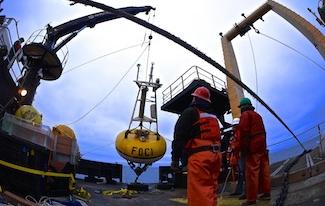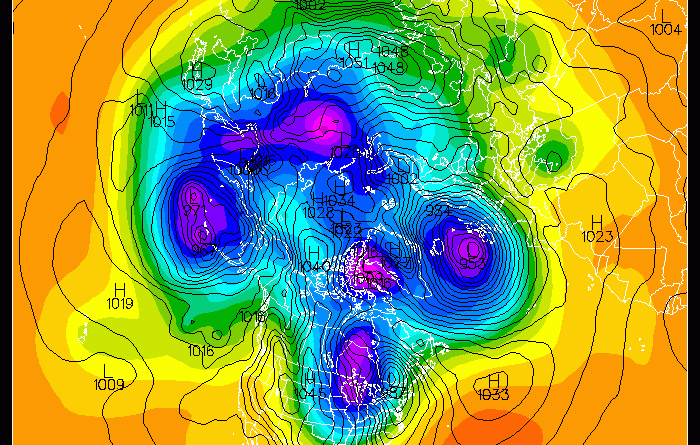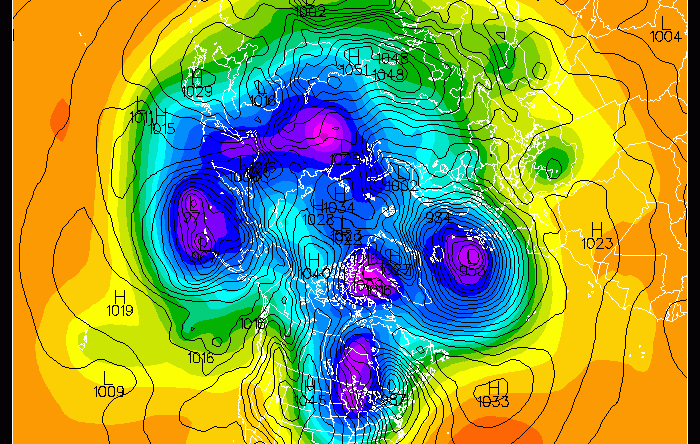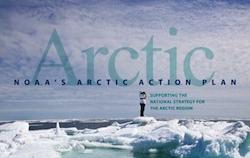What's New Archive
Released October 21: The 2010 Arctic Report Card highlights record temperatures across Canadian Arctic and Greenland, a reduced summer sea ice cover; record snow cover decreases and links to some Northern Hemisphere weather to support the conclusion that a return to previous Arctic conditions is unlikely.
PMEL scientist Dr. James Overland, co-editor of the Arctic Report Card, describes how the Arctic climate is impacting mid-latitude weather, as seen in Winter 2009-2010, in the Atmosphere section of the report.
Please visit the 2010 Arctic Report Card web site for the full report.
In recent press, notably the New York Times, Arctic atmosphere circulation has been a hot topic. PMEL's Dr. Jim Overland explains that the Polar Vortex, a ring of winds circling the North Pole and providing a fence keeping cold air north, has broken down for the second year in a row. This breakdown allows cold air to spill south, affecting the U.S. East Coast and other regions.
For more information on the Arctic atmosphere please visit the 2010 Arctic Report Card page and for the latest research on the Arctic visit the Arctic Future web site.
NOAA has updated the Arctic Future website to reflect recent observations and add results in the Arctic Council 2011 Snow, Water, Ice and Permafrost in the Arctic assessment. Other topics include: satellites show the Arctic losing summer sea ice for the past 30 years, an increased linkage between the Arctic and mid-latitudes, and glacier melt contributing to sea level rise.
Read more at NOAA’s Arctic Future website.
Released in the beginning of December the 2011 Arctic Report Card concludes that there are now a sufficient number of years of observational data to indicate a shift in the Arctic Ocean system since 2006. Persistent warming and record-setting changes are occurring throughout the Arctic environment with resultant impacts on Arctic ecosystems.
PMEL’s Drs. James Overland and Sue Moore contributed to the report that was prepared by an international team of 121 scientists from 14 different countries.
A study led by PMEL's Dr James Overland, published in the October 10 issue of Geophysical Research Letters, shows how changes in summer Arctic wind patterns contribute not only to unprecedented loss of Arctic sea ice, but could also bring about shifts in North American and European weather.
Dr. Overland and others shows a change in the summer Arctic wind pattern over the past six years when compared to patterns for the previous 20 years. For more information see the NOAA press release.
JISAO scientist, Dr. Kevin Wood, along with NOAA and the U.S. National Archives are teaming with Old Weather and thousands of citizen volunteers to transcribe climate data from historical ship logbooks into modern digital formats that can be used to extend modern global climate data sets to earlier times in order to better understand the climate of today.
Visit the new Arctic Rediscovery website which includes a gallery of photos revealing fascinating details of life on historical ships in the Bering Sea/Arctic, related student projects, and other resources.
The Arctic region continued to break records in 2012 - among them, the loss of summer sea ice, late spring snow cover, and melting of the Greenland ice sheet - as the region settles into a new state. This was true even though air temperatures in the Arctic were unremarkable relative to the last decade.
Major findings include record lows in snow and Arctic sea ice extent, record setting glacier and Greenland ice sheet melt, and greening of the tundra, with varied impacts on marine and terrestrial ecosystems.
PMEL and Alaska Fisheries Science Center’s EcoFOCI program just deployed the M2 mooring in the southeastern Bering Sea for the 20th consecutive year. The mooring has been providing year-round measurements of temperature, salinity, nitrite, chlorophyll, and currents in this highly productive area since 1994. These measurements are used in annual report cards and stock assessments provided to the North Pacific Fishery Management Council. Long-term time-series at this site are a critical tool for adapting to climate change and guiding sustainable management of living resources in the Bering Sea.
Visit the EcoFOCI website for more information on their work in the Bering Sea, Gulf of Alaska, and Arctic waters
PMEL’s Dr. James Overland explains why the eastern United States is experiencing frigid temperatures in early January 2014 on the Arctic web site's new Polar Vortex page. He describes how in the last five years we have seen the jet stream transform from its typical, nice oval pattern around the North Pole to more of a wavy formation, and this waviness is resulting in colder weather being carried into the eastern US and eastern Asia.
Visit the Arctic web site to read more about the polar vortex and how the connection between the Arctic warming trend and more severe weather in mid-latitudes is an active area of research.
NOAA Arctic Program Leads, including PMEL scientist and Arctic expert Dr. James Overland, collaborated on the development and recent publication of NOAA's Arctic Action Plan. The plan provides a roadmap to making shared progress in monitoring, understanding, and protecting the vulnerable Arctic region. PMEL is actively involved in Arctic climate dynamics research, conducting observations and evaluating models of Arctic sea ice to document and predict climate change impacts on Arctic marine ecosystems.
Find out more on the NOAA Arctic theme page and PMEL Arctic research web pages.






